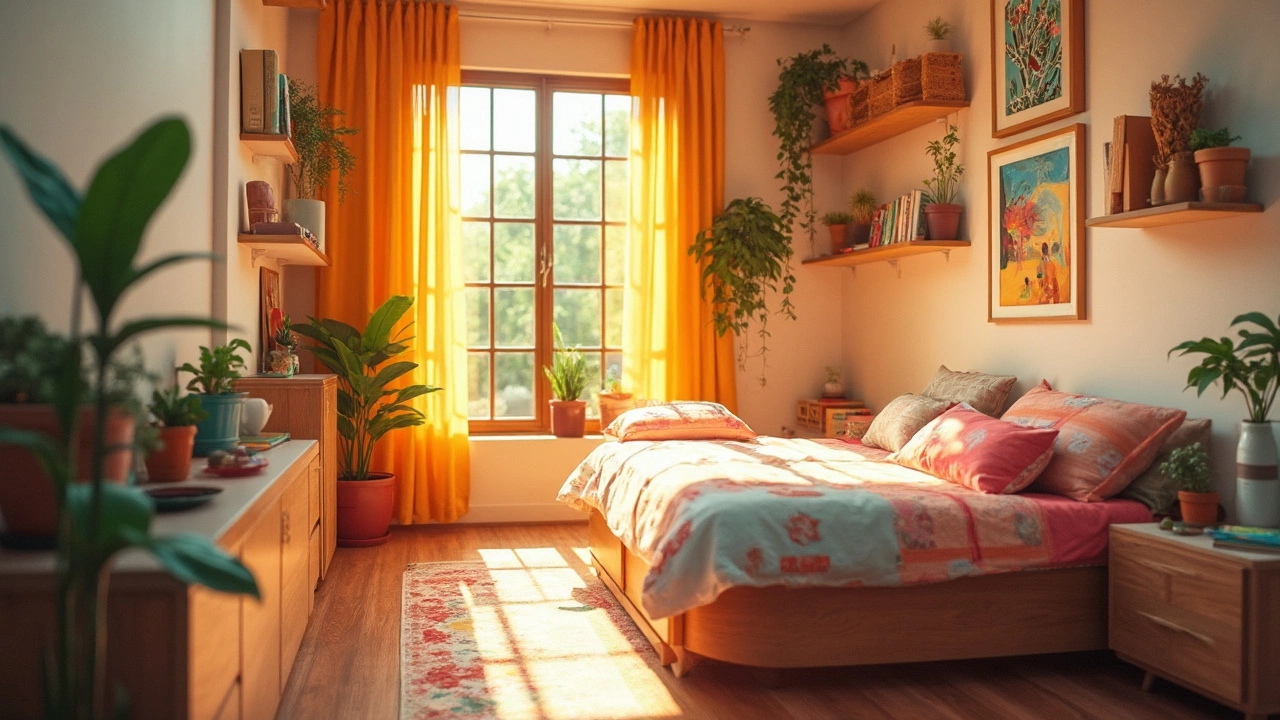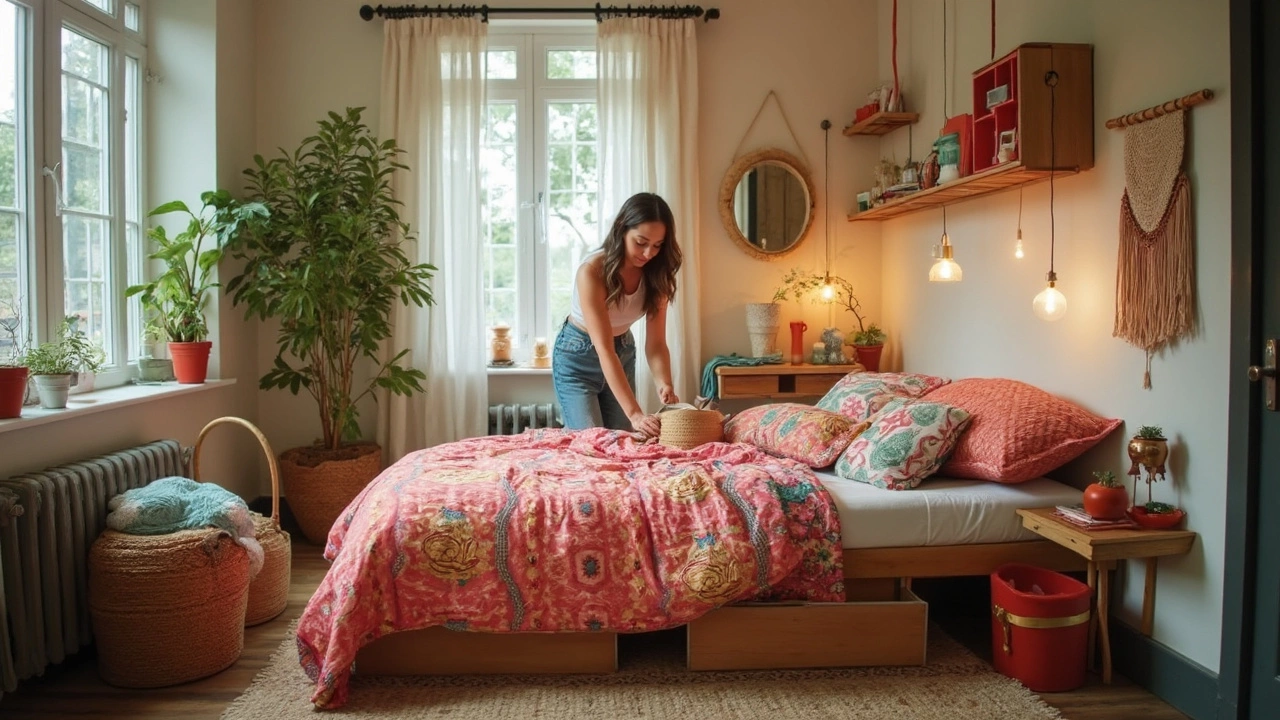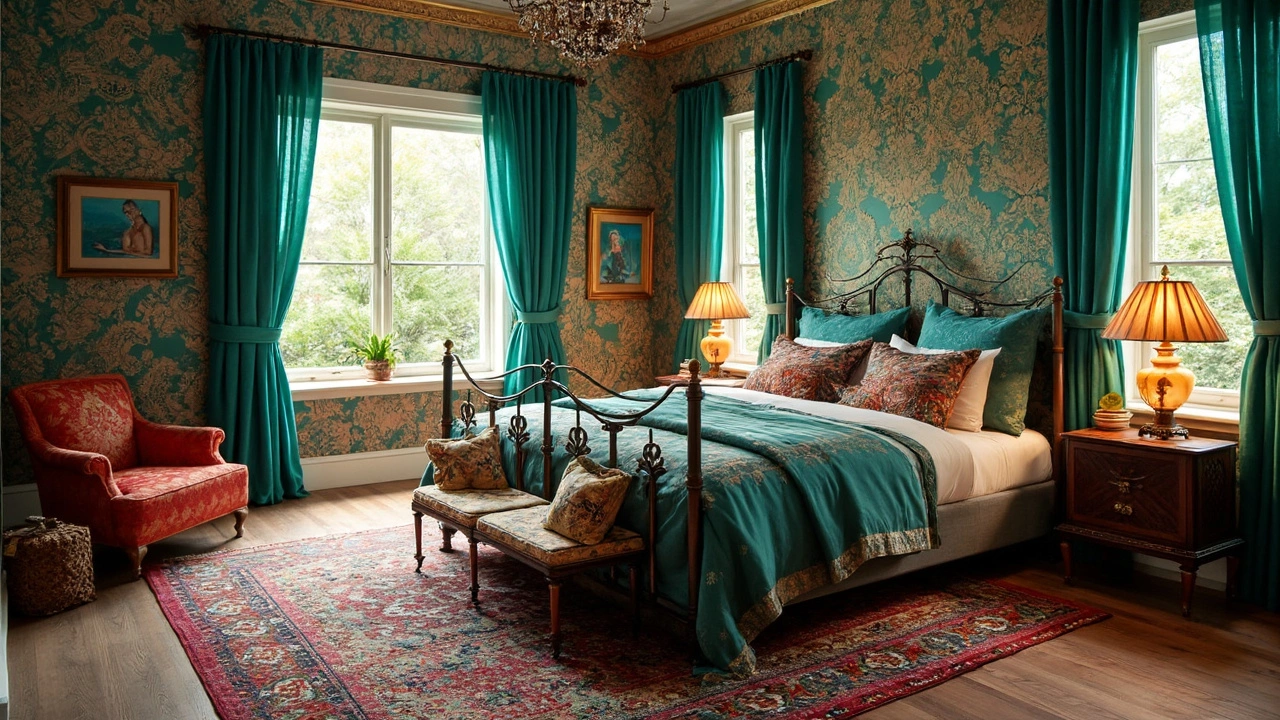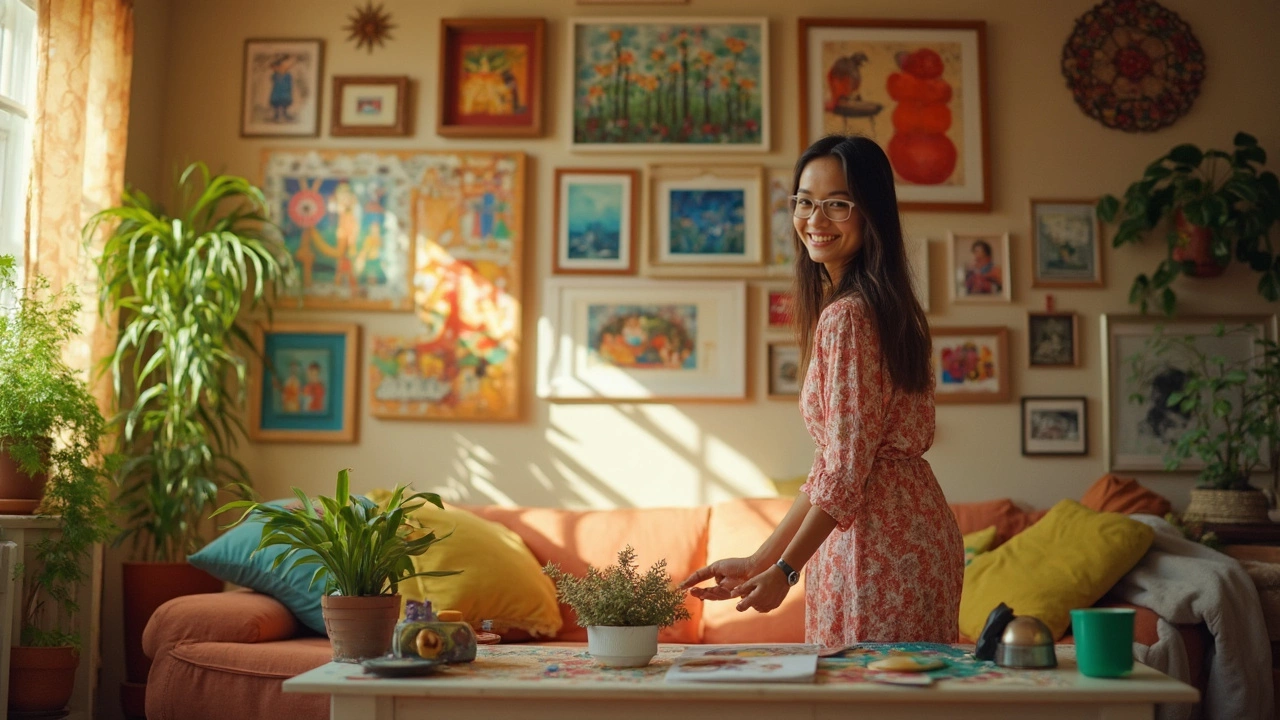How to Make a Small Bedroom Look Amazing: Simple Tricks That Wow

Most small bedrooms end up looking even smaller just because of clutter and bulky furniture choices. Ever walk into a room and feel like it’s closing in? That’s almost always because stuff’s everywhere and the layout doesn’t play to the room’s strengths.
Start by taking a serious look at the floor plan. Pushing the bed against the longest wall can open up much-needed space in the middle. Skip the idea that everything needs to match—sometimes a mix of furniture types frees up awkward corners for storage or seating you wouldn’t expect.
Storage matters big time. You don’t have to buy fancy organizers. Sometimes simple bins under the bed or wall shelves at eye level do the trick. Try keeping the space under your bed clear, or stash off-season clothes in low bins there. If you’re using dressers or nightstands, look for options with drawers—closed storage looks way cleaner, even if you’re not a neat freak.
- Smart Layouts That Actually Work
- Pick the Right Furniture—Not Just Small Stuff
- Make Storage Disappear (and Room Appear)
- Play with Color and Light for Instant Space
- Add Personality Without Clutter
- Quick Fixes That Fool the Eye
Smart Layouts That Actually Work
So you’ve got barely enough room to swing your feet off the bed. That’s normal with a small bedroom, but it doesn’t mean you’re doomed to trip over furniture every morning. A smart layout is like a cheat code for making a tight space look and work way better.
The first move? Ditch the idea that the bed must go dead center. Sliding it into a corner frees up floor space and gives you a big chunk of open area. Designers say this is the single most effective layout change for small bedrooms. You can toss in a slim nightstand or even a stack of books as a side table, saving space while still keeping things within reach.
If you’re working with literally no room to spare, try a floating bed layout. Stick your bed against the wall and skip a headboard—this keeps things airy. Want numbers? Interior design studies show that moving your bed to the corner can open up as much as 30% more usable floor space.
Besides the bed, think vertical. Wall shelves above eye level let you stash stuff without eating into your walking space. If there’s space at the foot of your bed, try a trunk or a bench with storage. For shared bedrooms, split the space with tall bookshelves—they act as faux walls and double as storage.
- Measure before you move—knowing your exact mattress and wall lengths saves a lot of stress.
- Leave at least 24 inches for walkways, especially on the side you use most.
- Put power strips and chargers close to the bed for easy access (no more crawling on the floor).
- Consider corner desks or fold-down wall desks if you need a workspace.
Here’s a quick look at layout tips from real-life small bedroom owners:
| Layout Tweak | Space Gained |
|---|---|
| Bed pushed into a corner | Up to 30% more open floor |
| Wall shelves above eye level | Adds 10-15% more storage |
| Under-bed storage bins | Hides 1-2 large suitcases worth of stuff |
Change the layout just once and you’ll be surprised by how much bigger the room feels. It’s not magic—it’s just basic geometry with a dose of common sense.
Pick the Right Furniture—Not Just Small Stuff
The first mistake most people make is grabbing only tiny furniture for their small bedroom. While it might seem logical, lots of little pieces just end up making the space crowded and chaotic. What works better? Fewer, but smarter choices.
Start with your bed. Go as big as you actually need, but no bigger. Queen beds fit in most small bedrooms, and if you pick one with storage drawers underneath, you’ve solved two issues at once. If you have a little nook or alcove, consider a daybed or a bed that tucks right into the space.
Multifunctional furniture is your new best friend. Here’s what to look for:
- Storage beds or loft beds: A bed with drawers saves on closet space. Loft beds create room for a desk or seating underneath.
- Floating shelves: They provide a spot for books or a lamp without eating up floor area.
- Fold-down desks or wall-mounted tables: Perfect for study or work, but takes up almost no space when not in use.
- Ottomans with storage: Extra seating plus hidden storage.
Don’t forget to measure before buying anything. Around 18-24 inches of walking space between furniture and walls is ideal, or you’ll be banging your shins every morning.
Check out this quick data breakdown for best-selling small bedroom furniture pieces, based on 2024 online retail stats:
| Furniture Type | Percent of Small Bedroom Buyers |
|---|---|
| Storage Bed | 37% |
| Floating Shelves | 29% |
| Fold-down Desk | 14% |
| Nightstand with Drawers | 13% |
| Loft Bed | 7% |
Notice what’s common here? Storage is king. Always pick furniture that does more than just take up space. When each piece pulls double duty, your room stays open, looks bigger, and works harder for you.
Make Storage Disappear (and Room Appear)
It's wild how much stuff piles up in a small bedroom, right? But here's the thing: finding sneaky storage fixes will make your space look way bigger and help you keep your sanity. A lot of people skip this step, but if you want your room to feel open, you need some clever moves.
The best call is picking double-duty furniture. Think beds with drawers underneath, or ottomans that pop open for hidden storage. And go vertical—anything you can hang or stack is a win. Here's something legit: according to IKEA’s design research, using wall shelves can give you up to 48% more floor area in tiny bedrooms. That's almost half the room reclaimed!
- Mount floating shelves above the bed or desk for books and baskets.
- Try tall wardrobes that go up to the ceiling—you’d be surprised how much fits in there.
- Use hooks on doors for bags, belts, or headphones. Even a shoe organizer over the door works for lots more than just shoes.
- Go for storage boxes under the bed; clear plastic ones make it easy to see what you’re grabbing, but fabric bins look neater if you don’t want to see the mess.
If you’re short on closet space, look for bed frames with built-in drawers. That move alone can hide away your off-season clothes, shoes, or even extra bedding. According to a survey by The Container Store, 63% of people in small apartments use underbed storage regularly to avoid clutter.
"In tight spaces, visually quieter storage is the best trick. Closed bins and underbed drawers make a room feel peaceful." — Emily Henderson, interior stylist
Here’s a little table of quick options and how much space you can save with each:
| Storage Solution | Average Space Saved (sq. ft.) |
|---|---|
| Underbed Storage Drawers | 12-24 |
| Wall Shelves (two rows) | 8-14 |
| Over-the-door Organizers | 3-5 |
| Tall Wardrobe | 10-20 |
The more you can make storage “disappear,” the more your bedroom will actually feel, look, and work like a bigger room. When in doubt, put things behind closed doors or in boxes. It’s weirdly satisfying, and your room will thank you for it.

Play with Color and Light for Instant Space
Colors and light are basically cheat codes for making a small bedroom look bigger. Lighter shades reflect more light, which makes the walls feel further apart. Super simple: Paint your walls white, off-white, pale grey, or soft pastels. These colors bounce sunlight all over the room. Even one wall painted lighter than the others can give the illusion of more space.
You probably know that dark colors shrink a room. But if you really love bold color, try it just on one feature wall behind your bed. It adds style without cramping everything in.
Lighting is just as important as paint. Small bedrooms almost always suffer from poor overhead lighting. Swap those boring ceiling bulbs for softer, warmer LEDs. If you can, add floor lamps or sconce lighting to the corners. A few lamps at different heights can actually trick your brain into thinking there’s more depth in the room.
It’s not just about wattage, either. When sunlight comes in, don’t block it. Sheer curtains or blinds let the room stay bright but still give you privacy. If privacy isn’t a big concern, keep the windows clear—your room instantly looks bigger during the day.
Here’s a quick breakdown of how color and lighting choices can affect the feel of your bedroom:
| Element | How It Impacts Space | Pro Tip |
|---|---|---|
| Wall Color | Light colors make rooms feel open; dark colors close them in | Stick to 1-2 shades max |
| Lighting Type | Multiple sources add depth | Mix ceiling and wall lamps |
| Window Coverings | Sheer lets in more daylight | Go for light or neutral colors |
| Accent Wall | Adds style without losing openness | Try deep blue or forest green |
One more tip: avoid using too many different colors or light sources. Keeping things consistent makes a small bedroom feel calm, organized, and way less cramped.
Add Personality Without Clutter
Just because your room is small doesn’t mean it should feel bland or like a hotel. But the trick is to bring in your style without turning the place into a storage closet. A lot of people make small bedrooms look busier by crowding them with trinkets or overdoing the décor. The secret? Pick your favorite pieces, keep it simple, and let them shine.
Focus on a few meaningful items. Maybe you love vinyl records or retro cameras—show them off, but stick to just a couple on a shelf. Gallery walls are popular, but in a small room, limit it to three or four pieces so it doesn’t feel chaotic. You can swap out frames or prints for a fresh look every few months. For soft touches, use patterned throw pillows or a bold blanket. One or two statement pieces do way more than a dozen small ones.
- Use vertical space—hang art, floating shelves, or plants up high to draw the eye upward and make the room look taller.
- Mount wall lamps or string lights instead of using table lamps that eat up precious space on nightstands.
- Go for dual-purpose items: a stylish basket to stash blankets, or a stool that works as a nightstand and extra seat when you need it.
If you love colors and patterns, use them in your bedding or a rug. Keep the rest of the room calm—mostly one or two base colors. Experts say people with less clutter in their bedrooms generally sleep better because the space feels more restful.
Ready for a quick comparison?
| Approach | Effect on Space | Best Use |
|---|---|---|
| Gallery wall with 10+ pictures | Feels busy and cramped | Large rooms, open walls |
| 3-4 framed prints | Personal, but neat | Small rooms |
| Open shelves full of knick-knacks | Looks cluttered | Always organized collectors |
| A few favorite pieces on shelf | Clean, focused style | Small bedroom |
Bottom line: Make it personal, but be picky. You’ll love your room more when you actually notice the stuff you really care about instead of dusting a pile of extras that just fill up space.
Quick Fixes That Fool the Eye
Want your small bedroom to look instantly bigger? There are a bunch of quick tricks that work way better than people think. No heavy remodeling needed. Just a few changes can stretch your space and make it feel brighter and more open.
First, use mirrors. Seriously, it sounds so basic, but they double the daylight in your room and make the walls look farther apart. Toss one on the back of your door or hang a large mirror across from a window. Even a group of smaller mirrors can bounce light around your room.
Go light with your color choices, especially for the biggest surfaces—the walls, ceiling, and bedding. Whites and soft grays reflect more light, which helps a small bedroom feel way less boxy. If you want a pop of color, try it with a throw or small artwork, not the whole wall.
Think tall, not wide, when picking shelves or artwork. Vertical lines draw the eye up, making low ceilings seem higher. You can stack floating shelves or hang long curtains from ceiling to floor, even if your window is short—the taller it all looks, the bigger your room feels.
Don’t crowd your windows with heavy, dark curtains. Use sheer panels or blinds you can pull up all the way to let in natural light. Sunlight seriously does most of the work for you, and it doesn’t cost a thing.
- Swap bulky light fixtures for recessed lights, wall sconces, or LED strips behind your headboard. The more layers of light, the bigger the space feels at any hour.
- Keep your floor as clear as possible. Try wall-mounted nightstands or lamps. Even small rooms look larger if you can see more floor.
- Pick rugs that run wall-to-wall or nearly so, instead of tiny ones. A bigger rug makes your room look more expansive, not the other way around.
All these tweaks are budget-friendly and easy enough to do yourself. Give one or two a shot, step back, and you’ll see your small bedroom with new eyes—no magic, just smart design.


